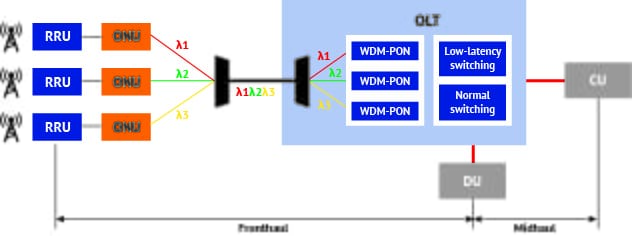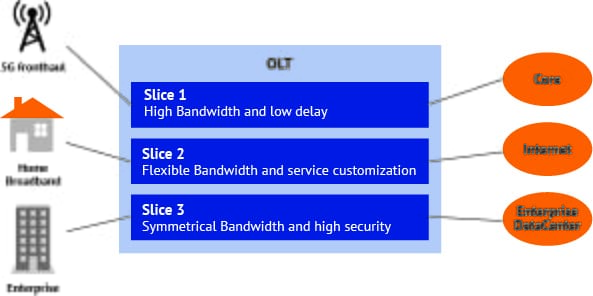Previous generations of mobile networks (LTE, 3G, etc.) consisted of simply offering fast, reliable mobile data services to the network users. But 5G increased this scope to offer a broader range of wireless services to be delivered to the end user across multiple access platforms and multi-layer networks, where applications and performance will be tailored precisely to their needs. It is widely viewed as more than a new generation of technologies, which requires pushing the limits of the underlying technologies. Cell phone operators began deploying 5G networks worldwide in 2019, and it is expected that by 2025, 5G networks are likely to cover one-third of the world’s population.
The architecture of the network is divided into Fronthaul, Midhaul and Backhaul. In the 4G architecture, the Fronthaul connected the Remote Radio Heads (RRHs) to distant centralized/cloud Baseband Units (BBUs) and the Backhaul connected the BBUs back to 4G Evolved Packet Core (EPC). In 5G, the Fronthaul is subject to very low latency requirements. This caused the BBUs, which can be disaggregated (and virtualized), to be split into a Central Unit (CU) and a Distributed Unit (DU) and a new “Midhaul” that interconnects the CU to the DU via a new standardized 3GPP F1 interface. Even further layer splits were introduced by the ITU-T in G.Supp 66section 6.2.2 to facilitate RAN virtualization and increase data rates, especially option 7 (Intra PHY split). The 5G fronthaul radio also requires much tighter time synchronization to achieve some key features, like inter-site Carrier Aggregation, MIMO and Coordinated Multi-point (CoMP). For example, most deployments target a figure of ±130ns between RRUs connected to the same DU.
As stated in G.Supp 66 (07/2019) section 6.1, 5G Backhaul is essentially the same as in 4G, even though it is carrying much more traffic due to higher performance and higher bandwidth 5G New Radios (NRs).

In this blog, the focus will be on the 5G Fronthaul where PON (Passive Optical Networks) technology is used. PON networks, in this case, consist of the OLT (Optical Line Terminal) which communicates with multiple “tunable” ONUs (where the filter is tuned to pass only the desired downstream wavelength to the receiver). The tunable ONUs are connected to a central OLT over a single bi-directional fiber linkwhich lowers the amount of fibers needed. The WDM-PON system is most common in the 5G Fronthaul networks. It combines the WDM (Wavelength Division Multiplexing) technology and the PON topology, where one wavelength is used for downstream traffic and another for upstream traffic on a single mode fiber (ITU-T G.652). Note that existing WDM-PON today is not yet standardized. Vendors such as Huawei and ZTE come up with their own WDM implementations.
WDM-PON is not a very good fit for all networks though, namely in the western networks where other solutions are needed. Traditional TDM-PON can also be improved on the upstream to meet 5G front-haul requirements by using the co-operative DBA mechanism (G.Supp 66section 9.3). PON OLT chip vendors, such as Broadcom, open up the DBA interface to implement such DBA schemes.
This presents the following advantages that the 5G Fronthaul architecture can leverage, and that makes using PON networks increasingly indispensable for 5G deployments:
- High bandwidth: 5G services require much higher amounts of bandwidth.
- Low latency: 5G put forward a new set of applications requiring very low latency and high reliability connectivity to the cloud.
- Plug-and-play ONU (Optical Network Unit).
- Simple OAM (Operation Administration and Maintenance).
- Low amount of fibers needed which lowers construction and maintenance cost.
In addition to satisfying two of the main pillars of 5G (higher bandwidth and lower latency), this flexible PON architecture enables supporting more people and devices connecting at the same time without overloading the network.
The diagram belowshows the architecture of the WDM-PON 5G Fronthaul network and shows how the OLT fits in the 5G network. In this example, one DU and multiple RRUs are connected via a WDM-PON point-to-multipoint topology. The WDM-PON OLT is connected to the DU while the ONUs are connected to the RRUs. he WDM and AMCC (auxiliary management and control channel) technologies are used to enable transparent user data transmission between the DU and RRUs. If we compare with active bearer equipment and TDM PON, this architecture offers low latency, low frequency jitter, and flexible configuration of different fronthaul interfaces. It also offers a dedicated wavelength to each user, high transmission efficiency, and extensive bandwidth resources.
The OLT carries the fronthaul traffic between the DU and RRUs as well as the Midhaul traffic between the DU and CU.

One other feature of the OLT is the ability to implement the network slicing concept. Network slicing effectively allows the service provider to create logical networks across a common physical infrastructure. As already mentioned, 5G is not just about providing huge data rates to the subscriber. It is about becoming an enabler network for lots of different applications, and different third-party users of the network. We will need to be able to create a very adaptive flexible network that will provide different customers/third parties with different features, and network slicing is a perfect solution to do this. We ultimately provide that flexibility to accommodate the variety of different potential service environments.
The diagram below shows a representation of how the OLT could slice the network into multiple services, each characterized by different bandwidth profiles:
- 5G Fronthaul: High Bandwidth and low delay
- Home Broadband: Flexible bandwidth and service customization
- Government and Enterprise: Symmetrical bandwidth and high security


